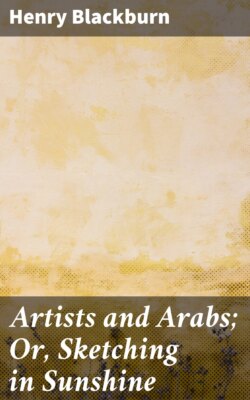Читать книгу Artists and Arabs; Or, Sketching in Sunshine - Blackburn Henry - Страница 9
На сайте Литреса книга снята с продажи.
Original
ОглавлениеBuilt close to the water's edge, so close that the Mediterranean waves are sapping its foundations—with plain white shining walls, nearly destitute of exterior ornament, it is perhaps 'the most perfect example of strength and beauty, and of fitness and grace of line, that we shall see in any building of this type. * It is thoroughly Moorish in style, although built by a Christian, if we may believe the story, of which there are several versions; how the Moors in old days took captive a Christian architect, and promised him his liberty on condition of his building them a mosque; how he, true to his own creed, dexterously introduced into the ground plan the form of a cross; and how the Moors, true also to their promise, gave him his liberty indeed, but at the cannon's mouth through a window, seaward.
* This beautiful architectural feature of the town has not
escaped the civilizing hand of the Frank; the last time we
visited Algiers we found the oval window in the tower gone,
and in its place an illuminated French clock!
The general outline of these mosques is familiar to most readers, the square white walls pierced at intervals with quaint-shaped little windows, the flat cupola or dome, and the square tower often standing apart from the rest of the structure as in the little vignette on our title-page, like an Italian campanile. Some of these towers are richly decorated with arabesque ornamentation,' and glitter in the sun with colour and gilding, but the majority of the mosques are as plain and simple in design as shown in our large sketch.
Here, if we take off our shoes, we may enter and hear the Koran read, and we may kneel down to pray with Arabs and Moors; religious tolerance is equally exercised by both creeds. Altogether the Mahommedan places of worship seem by far the most prominent, and although there is a Roman Catholic church and buildings held by other denominations of Christians, there is none of that predominant proselytizing aspect which we might have expected after thirty years' occupation by the French! At Tetuan, for instance, where the proportion of Christians to Mahommedans is certainly smaller, the 'Catholic church' rears its head much more conspicuously.
In Algiers the priestly element is undoubtedly active, and Soeurs de Charité are to be seen everywhere, but the buildings that first strike the eye are not churches but mosques; the sounds that become more familiar to the ear than peals of bells, are the Muezzin's morning and evening salutation from the tower of a mosque, calling upon all true believers to—
'Come to prayers, come to prayers,
It is better to pray than to sleep.'
The principal streets in Algiers lead east and west from the Place to the principal gates, the Bab-Azoun and the Bab-el-Oued. They are for the most part French, with arcades like the Rue de Rivoli in Paris; many of the houses are lofty and built in the style perhaps best known as the 'Haussman.' Nearly all the upper town is still Moorish, and is approached by narrow streets or lanes,—steep, slippery, and tortuous, * which we shall examine by-and-bye.
* It may be interesting to artists to learn that in this
present year 1868, most of the quaint old Moorish streets
and buildings are intact—neither disturbed by earthquakes
nor 'improved' out of sight.
The names of some of the streets are curious, and suggestive of change. Thus we see the 'Rue Royale,' the 'Rue Impériale there is, or was until lately, a 'Place Nationale,' and one street is still boldly proclaimed to be the 'Rue dé la Révolution'!
In passing through the French quarter, through the new wide streets, squares and inevitable boulevards, the number of shops for fancy goods and Parisian wares, especially those of hairdressers and modistes, seems rather extraordinary; remembering that the entire European population of Algeria, agricultural as well as urban, is not much more than that of Brighton. In a few shops there are tickets displayed in different languages, but linguists are rare, and where there are announcements of the labels have generally a perplexing, composite character, like the inscription on a statue at the Paris Exhibition of 1867, which ran thus 'Miss Ofelia dans Amlet.'
Before we proceed further, let us glance at the general mode of living in Algiers, speaking first of the traveller who goes to the hotels.
The ordinary visitor of a month or two will drop down pleasantly enough into the system of hotel life in Algiers; and even if staying for the winter he will probably find it more convenient and amusing to take his meals in French fashion at the hotels, ringing the changes between three or four of the best, and one or two well-known cafés, There is generally no table-d'hôte, but strangers can walk in and have breakfast or dine very comfortably at little tables 'a part,' at a fixed hour and at a moderate price. The rooms are pleasant, cool, and airy, with large windows open to the sea.
Everything is neatly and quietly served, the menu is varied enough, with good French dishes and game in abundance; the hosts being especially liberal in providing those delicious little birds that might be larks or quails,—which in Algiers we see so often on the table and so seldom on the wing.
